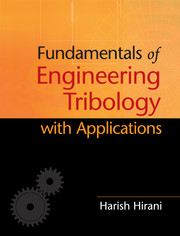Book contents
- Frontmatter
- Dedication
- Contents
- List of Figures
- List of Tables
- Preface
- Acknowledgments
- Nomenclature
- 1 Introduction
- 2 Friction, Wear and Boundary Lubrication
- 3 Lubrication of Bearings
- 4 Hydrodynamic Thrust Bearing
- 5 Hydrostatic and Squeeze Film Lubrication
- 6 Elasto–Hydrodynamic Lubrication
- 7 Gas (Air) Lubricated Bearings
- 8 Mixed Lubrication
- 9 Tribological Aspects of Rolling Motion
- 10 Tribological Aspects of Gears
- Index
- References
8 - Mixed Lubrication
Published online by Cambridge University Press: 05 March 2016
- Frontmatter
- Dedication
- Contents
- List of Figures
- List of Tables
- Preface
- Acknowledgments
- Nomenclature
- 1 Introduction
- 2 Friction, Wear and Boundary Lubrication
- 3 Lubrication of Bearings
- 4 Hydrodynamic Thrust Bearing
- 5 Hydrostatic and Squeeze Film Lubrication
- 6 Elasto–Hydrodynamic Lubrication
- 7 Gas (Air) Lubricated Bearings
- 8 Mixed Lubrication
- 9 Tribological Aspects of Rolling Motion
- 10 Tribological Aspects of Gears
- Index
- References
Summary
Many machine components like gears, cams, heavily loaded sliding bearings, etc., operate under mixed lubrication regime, which occurs when the applied load is shared between the full-film lubrication and asperity contact regions. In the asperity contact regions, only a small fraction of the total area supports the major fraction of load, and as a result very high compressive stresses are induced at the contacting asperities. To predict the real contact area, finding the stresses at asperity contacts and relating the same to the friction and wear is very difficult task. The performance of these tribo–systems is limited due to the damages caused by wear, scuffing, etc. The key feature of mixed lubrication is the presence of asperity interactions at several locations along with separation of surfaces by thin lubricant film at numerous other locations, their individual proportions being dependent upon the operating conditions. Due to the presence of asperity contacts and very thin lubricant film, the surface roughness assumes significance in determination of the tribological performance in mixed lubrication. This chapter covers the current understanding of the mixed lubrication.
Introduction
In many applications like gears, cams, valves, the operating conditions warrant the operation to lie in mixed lubrication regime. In addition, under very heavy loads, slow relative speed, insufficient surface area and scarcity of lubricant, the formation of thick film necessary for hydrodynamic lubrication becomes difficult and interacting surfaces contact each other at several locations and tribo–pairs operate in mixed lubrication. This lubrication regime has been depicted as zone 2 on a Stribeck curve described in Fig. 1.7.13 (chapter 1).
The sketch shown in Fig. 8.1 depicts a model of mixed lubrication regime, in which the applied load is shared by the fluid film and the asperity contacts. Two distinct regions: first, where fluid film separates the tribo–pairs and second where the asperities are in contact are shown in the Fig. 8.1. The asperity contacts under relative speed results in wear. The worn out particles may also scratch the contacting surfaces and increase wear rate.
Many researchers [Lu and Khonsari, 2005; Khonsari and Booser, 2006; Moshkovich et al., 2011] have proposed different methods of identifying the operative lubricating regime. However, the most commonly used method is to specify the specific film thickness (Λ) [Khonsari and Booser, 2006].
- Type
- Chapter
- Information
- Fundamentals of Engineering Tribology with Applications , pp. 326 - 370Publisher: Cambridge University PressPrint publication year: 2016
References
- 1
- Cited by



